|
ID
|
Thumbnail |
Media Data |
| 7227 |
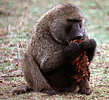
|
|
Scientific Name
|
Papio anubis
|
|
Location
|
Maasai Mara National Reserve, Kenya
|
|
Comments
|
Baboons occasionally kill and eat mammalian prey. In this case the source of the meat was unknown.
|
|
Specimen Condition
|
Live Specimen
|
|
Identified By
|
David Bygott
|
|
Behavior
|
Predation or scavenging
|
|
Sex
|
Male
|
|
Life Cycle Stage
|
Adult
|
|
View
|
Fronto-lateral
|
|
Copyright
|
© 2005

|
|
Image Use
|
ToL use only
|
|
Creation Date
|
1999
|
|
Attached to Group
|
Papio (Cercopithecidae): view page image collection
|
|
Title
|
bab+meat.jpg
|
|
Image Type
|
Photograph
|
|
Image Content
|
Specimen(s)
|
|
ALT Text
|
Adult male olive baboon (Papio anubis) eating meat
|
|
ID
|
7227
|
|
| 7228 |
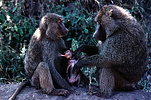
|
|
Scientific Name
|
Papio anubis
|
|
Location
|
Lake Manyara National Park, Tanzania
|
|
Comments
|
Baboons live in troops of about 50 individuals. Within the troop, an individual male may form friendships with one or more females. Here an adult male (right) grooms a black infant, i.e. one that is six months old or less. The infant clings to its mother, suckling.
|
|
Specimen Condition
|
Live Specimen
|
|
Identified By
|
David Bygott
|
|
Behavior
|
Grooming, nursing, affiliative
|
|
Sex
|
male and female
|
|
Life Cycle Stage
|
Adult male, adult female, infant
|
|
View
|
Lateral
|
|
Copyright
|
© 2005

|
|
Image Use
|
ToL use only
|
|
Creation Date
|
1985
|
|
Attached to Group
|
Papio (Cercopithecidae): view page image collection
|
|
Title
|
babfamily.jpg
|
|
Image Type
|
Photograph
|
|
Image Content
|
Specimen(s)
|
|
ALT Text
|
A male baboon (Papio anubis) grooms an infant suckling from its mother
|
|
ID
|
7228
|
|
| 7229 |
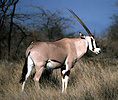
|
|
Scientific Name
|
Oryx gazella beisa
|
|
Location
|
Samburu Reserve, Kenya
|
|
Comments
|
The oryx is well adapted to life in dry areas. It is light-colored to reflect radiant heat, it can sustain prolonged high body temperature, it browses mainly at night to maximise water intake and it seldom needs to drink. Long straight horns are present in both sexes and are used in defense against predators.
The red-billed oxpecker bird on the oryx's rump is specialised for eating ectoparasites such as ticks.
|
|
Specimen Condition
|
Live Specimen
|
|
Identified By
|
David Bygott
|
|
Life Cycle Stage
|
Adult
|
|
View
|
Lateral
|
|
Copyright
|
© 2005

|
|
Image Use
|
ToL use only
|
|
Creation Date
|
1981
|
|
Attached to Group
|
Oryx gazella: view page image collection
|
|
Title
|
beisaoryx.jpg
|
|
Image Type
|
Photograph
|
|
Image Content
|
Specimen(s)
|
|
ALT Text
|
Beisa Oryx (Oryx gazella) and oxpecker in Samburu Reserve, Kenya
|
|
ID
|
7229
|
|
| 7230 |
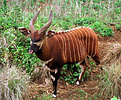
|
|
Scientific Name
|
Tragelaphus (Boocerus) eurycerus
|
|
Location
|
Mt Kenya Safari Club, Kenya
|
|
Comments
|
The bongo is restricted to certain tropical African forests. This is one of a captive breeding group held at the Animal Orphanage of the Mt Kenya Safari Club. Wild populations still exist in Kenya in the forests of the Aberdares and Mt Kenya.
|
|
Specimen Condition
|
Live Specimen
|
|
Identified By
|
David Bygott
|
|
Sex
|
Male
|
|
Life Cycle Stage
|
Adult
|
|
View
|
Fronto-lateral
|
|
Copyright
|
© 2005

|
|
Image Use
|
ToL use only
|
|
Creation Date
|
1999
|
|
Attached to Group
|
Tragelaphus eurycerus (Bovidae): view page image collection
|
|
Title
|
bongo.jpg
|
|
Image Type
|
Photograph
|
|
ALT Text
|
Adult male bongo (Tragelaphus eurycerus) on Mt Kenya
|
|
ID
|
7230
|
|
| 7231 |
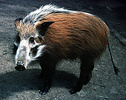
|
|
Scientific Name
|
Potamochoerus porcus
|
|
Location
|
Arusha, Tanzania
|
|
Comments
|
Young captive specimen probably from the Mt Meru population.
|
|
Specimen Condition
|
Live Specimen
|
|
Identified By
|
David Bygott
|
|
Life Cycle Stage
|
Young adult
|
|
View
|
Lateral
|
|
Copyright
|
© 2005

|
|
Image Use
|
ToL use only
|
|
Creation Date
|
1978
|
|
Attached to Group
|
Potamochoerus porcus (Potamochoerus): view page image collection
|
|
Title
|
bushpig.jpg
|
|
Image Type
|
Photograph
|
|
Image Content
|
Specimen(s)
|
|
ALT Text
|
Bushpig (Potamochoerus porcus), Tanzania
|
|
ID
|
7231
|
|
| 7232 |
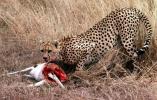
|
|
Location
|
Serengeti National Park, Tanzania
|
|
Comments
|
This cheetah had just killed an adult Thomson's gazelle, and after eating part of the haunch she dragged the carcass into the taller grass where she would be less easily seen by competitors such as hyaenas.
|
|
Specimen Condition
|
Live Specimen
|
|
Identified By
|
David Bygott
|
|
Behavior
|
Predation
|
|
Sex
|
Female
|
|
Life Cycle Stage
|
Adult
|
|
View
|
Lateral
|
|
Copyright
|
© 2005

|
|
Image Use
|
ToL use only
|
|
Creation Date
|
1977
|
|
Attached to Group
|
Acinonyx jubatus: view page image collection
|
|
Title
|
cheetahkill.jpg
|
|
Image Type
|
Photograph
|
|
Image Content
|
Specimen(s)
|
|
ALT Text
|
Cheetah (Acinonyx jubatus) eating a Thomson's gazelle in Serengeti NP. Tanzania
|
|
ID
|
7232
|
|
| 7233 |
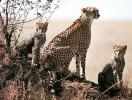
|
|
Location
|
Serengeti National Park, Tanzania
|
|
Comments
|
Cheetah with two cubs sitting on a termite hill, scanning the grassland for prey.
|
|
Specimen Condition
|
Live Specimen
|
|
Identified By
|
David Bygott
|
|
Behavior
|
Resting, searching for prey
|
|
Sex
|
Female
|
|
Life Cycle Stage
|
Adult female with cubs of about 6 months
|
|
View
|
Lateral
|
|
Copyright
|
© 2005

|
|
Image Use
|
ToL use only
|
|
Creation Date
|
1977
|
|
Attached to Group
|
Acinonyx jubatus: view page image collection
|
|
Title
|
cheetahcubscopy.jpg
|
|
Image Type
|
Photograph
|
|
Image Content
|
Specimen(s)
|
|
ALT Text
|
Cheetah (Acinonyx jubatus) with cubs in Serengei NP
|
|
ID
|
7233
|
|
| 7235 |

|
|
Location
|
Seronera, Serengeti National Park, Tanzania
|
|
Comments
|
The Small-spotted Genet is a common small nocturnal African carnivore. Though cat-like in behavior it is more closely allied to mongooses.
|
|
Specimen Condition
|
Live Specimen
|
|
Identified By
|
David Bygott
|
|
Behavior
|
Climbing, foraging
|
|
Life Cycle Stage
|
Adult
|
|
View
|
Lateral
|
|
Copyright
|
© 2005

|
|
Image Use
|
ToL use only
|
|
Creation Date
|
1976
|
|
Attached to Group
|
Genetta genetta (Carnivora): view page image collection
|
|
Title
|
genet.jpg
|
|
Image Type
|
Photograph
|
|
Image Content
|
Specimen(s)
|
|
ALT Text
|
Genet (Genetta genetta) climbing tree in Serengeti NP
|
|
ID
|
7235
|
|
| 7236 |

|
|
Scientific Name
|
Litocranius walleri
|
|
Location
|
Samburu Game Reserve, Kenya
|
|
Comments
|
The gerenuk or giraffe antelope has a long neck and the ability to stand on its hind legs. It can thus reach nutritious acacia foliage up to 2m above the ground, at times when all other vegetation is dry and brown.
|
|
Specimen Condition
|
Live Specimen
|
|
Identified By
|
David Bygott
|
|
Behavior
|
Feeding, standing bipedal
|
|
Sex
|
Male
|
|
Life Cycle Stage
|
Adult
|
|
View
|
Ventral
|
|
Copyright
|
© 2005

|
|
Image Use
|
ToL use only
|
|
Creation Date
|
1981
|
|
Attached to Group
|
Litocranius walleri: view page image collection
|
|
Title
|
gerenuk.jpg
|
|
Image Type
|
Photograph
|
|
Image Content
|
Specimen(s)
|
|
ALT Text
|
Male Gerenuk (Litocranius walleri) stands bibedally to browse in Samburu Reserve
|
|
ID
|
7236
|
|
| 7237 |
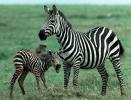
|
|
Scientific Name
|
Equus burchelli
|
|
Location
|
Ngorongoro Crater, Tanzania
|
|
Comments
|
The foal has just been born and is learning to stand. Its coat is still wet and shows traces of blood.
|
|
Specimen Condition
|
Live Specimen
|
|
Identified By
|
David Bygott
|
|
Behavior
|
Maternal
|
|
Sex
|
Female
|
|
Life Cycle Stage
|
Adult and neonate
|
|
View
|
Lateral
|
|
Copyright
|
© 2005

|
|
Image Use
|
ToL use only
|
|
Creation Date
|
1977
|
|
Attached to Group
|
Equidae (Perissodactyla): view page image collection
|
|
Title
|
PlainsZebra&inf.jpg
|
|
Image Type
|
Photograph
|
|
Image Content
|
Specimen(s)
|
|
ALT Text
|
Common or Plains Zebra (Equus burchelli) with newborn foal, Ngorongoro Crater
|
|
ID
|
7237
|
|











 Go to quick links
Go to quick search
Go to navigation for this section of the ToL site
Go to detailed links for the ToL site
Go to quick links
Go to quick search
Go to navigation for this section of the ToL site
Go to detailed links for the ToL site